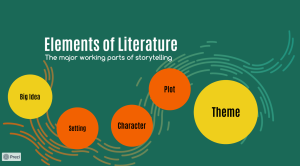3 Elements of Literature
Learning Objectives
-
Discuss the four major elements of literature: theme, setting, character, and plot. Look for these elements as you read.
-
Use metacognitive reading strategies before, during and after reading fiction, non-fiction and graphics
Chapter & Discussion
This chapter includes a presentation that can be navigated in a classroom setting or independently. You can access the presentation via the link below.
Elements of Literature: The Major Working Parts of Storytelling
Work through the different sections of the chapter and discuss ideas and topics as they arise. If you’re working independently, take notes instead. Notes and active discussion will be helpful in navigating this week’s assignments.
Big Idea: All Roads Lead to Theme
The four biggest elements of literature are theme, setting, character, and plot.
When an author tells a story, the big goal is to communicate big ideas, or themes.
The other elements can help the author communicate these ideas. These other elements serve as metaphors for the major themes that the author is trying to discuss.
Today, we’ll talk about how setting, character, and plot can be metaphors for themes.
A metaphor is a comparison between two (usually different) things.
One of them is typically used as a lens to look at the other.
“As she walked onto the stage, the electric shock of stage frieght made her freeze dead.”
Setting
Setting is the place, time, and other circumstances that affect the characters.
A setting can be a metaphor for a theme by representing images and ideas relevant to that theme.
In The Little Mermaid, the setting represents the way teenagers can feel trapped as they grow up: lacking control over their choices and freedom to explore the world.

Characters
Characters are the people who interact in the story.
A character can be a metaphor for a theme by having various qualities that are reflected in that theme.
In The Little Mermaid, the character Ariel is both a mermaid and a teenager. Both of these qualities help the author explore themes about growing up and the desire for freedom.
Ariel’s physical limitations help us to see her desire to explore the outside world.
Plot
The Plot is what happens in a story. It is the consequences of the characters’ choices.
The plot can be a metaphor for a theme by highlighting how certain choices can affect our outcomes.
When Ariel makes her deal with Ursula, her choice to give up her voice (in exchange for legs) turns sour, and she learns that the ability to express her ideas is more important than her body.
Theme
Ultimately, all of these major elements help authors say what they are trying to say.
Metaphor is a powerful tool that makes it possible to use setting, characters, and plot to communicate themes.
This is the major working principle of literature.

Assigned Reading
Here are this week’s readings. Additionally, please read for your own personal enjoyment for 1/2 hour each day. This will be called your “Reading Zone” reading and it will coincide with many upcoming activities.
The Seven Elements of a Story by Reedsy (Complete this in conjunction with assignment)
Short Films to Teach Story Elements (Use this in conjunction with assignment)
Practice Set: Elements of Literature
Click here to complete a practice set that explores concepts from the chapter.
These practice sets are designed to resemble the types of questions you’ll encounter on the GED RLA test. In this case, I am including a full novel chapter so that the reading can be engaging and so that you can have meaningful practice in the skill of close reading.
All of the practice sets in the Literature Unit will take on this format so that you can engage in enough practice to level up your reading skills while having access to literature that’s worth your time.
Assignment: Finding Relationships (300 Words)
This module has several steps. Please go through them in order.
-
Start by watching The Seven Elements of a Strong Story by Reedsy. You can stop after the “Plot” section, or keep going if you’re interested.
-
Now, I’d like you to pick an animated short from the following playlist: Short Films to Teach Story Elements. You may want to watch a few of these.
-
Now, I’d like you to respond to each of the following questions:
A. For the short film you selected, what is a theme you noticed?
B. Tell me about one of the following: setting, a character, or the plot.
C. Explain how the setting, a character, or a choice that a character made helped to reinforce the theme.
Assignment: Reading Zone Response (250 Words)
For Reading Zone, you must find a novel that is interesting to you and enjoyable to read. If you need help finding a Reading Zone book, please ask. Please read your Reading Zone book for a half-hour each day. On class days, there will be time in class dedicated to reading.
Create a response to this week’s reading that addresses the following prompts:
-
In one paragraph, summarize what you’ve read this week
-
In a second paragraph, discuss the setting, a character, or a choice, and explain how this element reinforces a theme in your book.


